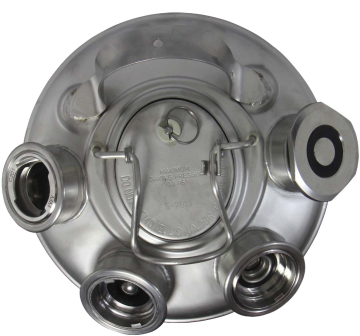The Importance of Clean Lines
There’s a lot to know about draft lines, so this crash course is just an introduction.

The hoses that connect beer kegs and casks to taps—the lines—need regular cleaning. Dirty lines adversely affect the flavour of beer. Contamination in the lines can also lead to foaming the beer and unexpected hangovers. Things like mould, calcium oxalate (beerstone), hop particulate, yeast, dimethyl sulfide (DMS), diacetyl, proteins, and bacteria build up and thrive in dirty lines. But these issues can be dealt with easily. Cleaning is a simple process, but it can be time consuming, wasteful, and inconvenient.
You can, of course, pay someone to clean your lines. There are a number of line cleaning companies in BC. I’ve used some of them and found the quality to vary wildly, so I now take care of line cleaning in house.
There’s a lot of discussion about how and when lines should be cleaned. This is how I like to do it, based on my training and what has changed with the craft beer revolution. Line cleaning is often easier with two people: one to attach the cleaner and one to pull it through. Mobile phones have made this much easier; there’s less need for running up and down stairs shouting.
Scheduling
Scheduling is important because line cleaning is an easy job to put off. Many places, like my old stomping ground, 12 Kings Pub, post their line cleaning dates at the bar and on social media. When I was there, I cleaned the lines every Friday. Friday was brewing day, so I took care of the lines and made sure the casks and kegs were all set for the weekend while I waited for the mash and boil. My policy is to never clean lines during service. This is mostly precautionary, so no customer is served a glass of anything other than what they ordered (#fuss), especially if it could be oxy cleaner.
I cleaned lines every week because cask lines need more frequent cleaning than keg lines. Cask lines are more exposed to more hop particulate, proteins and yeast, particularly since the massive increase of craft beer styles. Hoppy beers can quickly create hard-to-remove stains in the lines, and you are now more likely to find yeast and/or particulate in craft kegs, which was not the case when those lines carried sterile macro lagers.
Craft lines should be cleaned at least every two weeks. The taps also need to be disassembled and cleaned. This doesn’t necessarily need to be done every time, but cleaning the taps at every other line clean is a good routine. I recommend additional cleaning after a strong-tasting beer or before a busy event, too.
At Callister, I brew every 10–14 days, and I still clean my lines on brew days, usually before service starts. (After closing is arguably better, so any delays won’t affect service and/or cleaning standards, but this adds time on to the end of your work day.) Because of the serving setup at Callister, my cask lines are wide gauge and quite short, so this seems to be enough. Generally, cask lines should be cleaned slightly more frequently but with a weaker cleaning solution; heavy abrasives can damage the engines.

Cleaners and Supplies
The main chemical you should use is a commercial line cleaner. There are a few on the market that are variations on oxy-style powder cleaners. My favourite is made by Hydrochem Industries, a family company in North Vancouver whose proprietary blend hasn’t let me down. Never use bleach, soap, or any scented wash; these do not clean lines adequately and can leave noticeable residue that may take weeks to get rid of. You will need a cleaning can for keg lines and a bucket for cask lines. Add the powder to cold water (never water to cleaner) and give it a good shake or stir to mix. Wear protective gloves and goggles; once mixed it isn’t necessarily harmful to skin but always take precautions.
Cans can be plastic with one keg connector or steel with multiple heads for the different types of connector. Sankey “D” connectors are the most common in North America but most European kegs, nitro and Guinness all have different connectors.
Process
- Fill the cleaning can with water.
- Flush lines with water.
- Add cleaner to the can and shake or stir to mix.
- Fill lines with cleaner.
- Wait 10–15 minutes, then pull cleaner through.
- Repeat step 5.
- Flush with water (ideally with a few drops of sanitizer added).
- Pull through to beer.
If you start with a water flush and your lines are 20 feet or longer, the beer you pull through the line at first could be diluted with water so should not be sold, but is fine to drink or cook with. It might be interesting to save that sample and compare the taste with another sample after cleaning.
You can leave cleaner in the line for up to 40 minutes without a problem, but longer than that could affect seals, depending on the concentration. However, a long soak isn’t as effective as periodically moving new cleaner through. Oxy-cleaner has a slippery feel when dissolved so you can tell if it’s still in the lines or has been rinsed out. You can also get indicator powder that you add to your rinse water that will change colour in the presence of proteins in the line. This is a useful tool but far from essential.
I hope you find these articles interesting! If you have any questions or comments, please contact me @realcask
Next issue, I’ll be looking at my favourite style of beer and asking why the name turns so many people off.
This Post Has 0 Comments